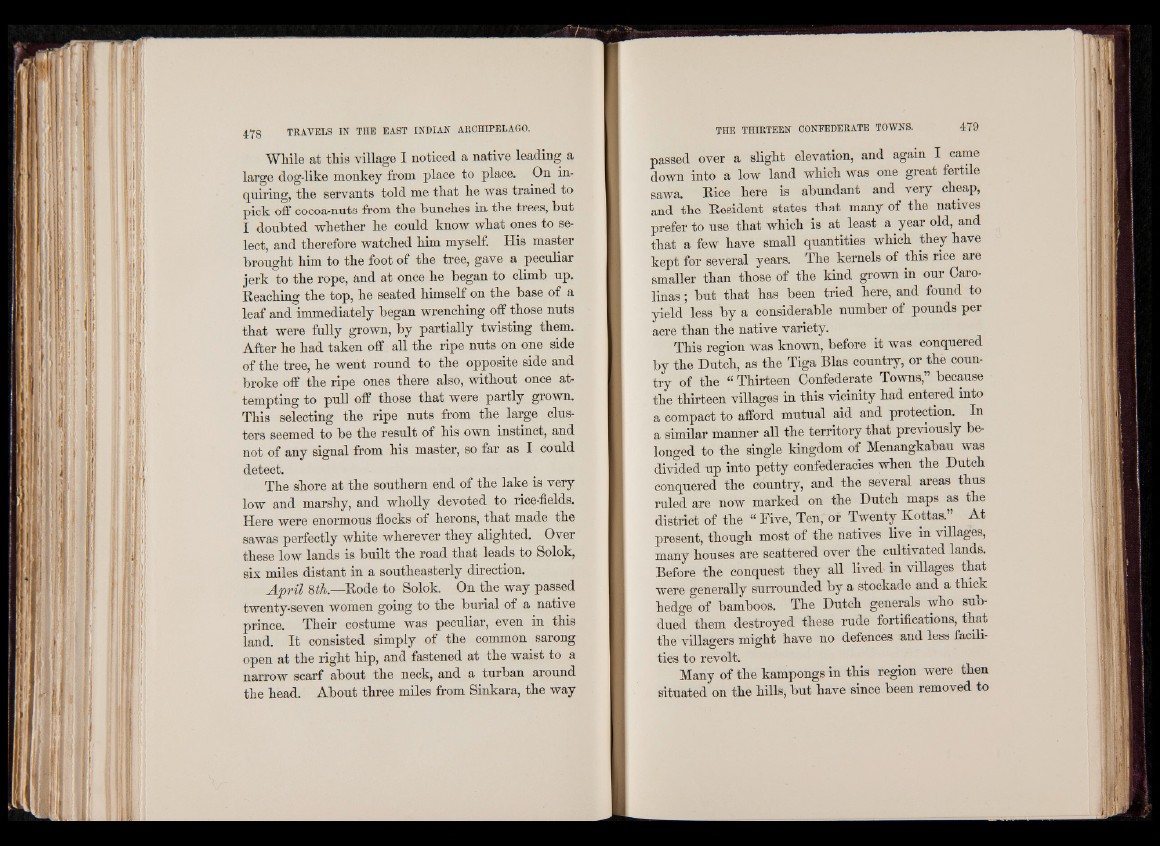
While at this village I noticed a native leading a
large dog-like monkey from place to place. On inquiring,
the servants told me that he was trained to
pick off cocoa-nuts from the hunches in. the trees, hut
I douhted whether he could know what ones to select,
and therefore watched him myself. His master
brought him to the foot of the tree, gave a peculiar
jerk to the rope, and at once he hegan to climh up.
Reaching the top, he seated himself on the hase of a
leaf and immediately hegan wrenching off those nuts
that were fully grown, hy partially twisting them.
After he had taken off all the ripe nuts on one side
of the tree, he went round to the opposite side and
broke off the ripe ones there also, without once attempting
to pull off those that were partly grown.
This selecting the ripe nuts from the large clusters
seemed to he the result of his own instinct, and
not of any signal from his master, so far as I could
detect.
The shore at the southern end of the lake is very
low and marshy, and wholly devoted to rice-fields.
Here were enormous flocks of herons, that made the
sawas perfectly white wherever they alighted. Over
these low lands is built the road that leads to Solok,
six miles distant in a southeasterly direction.
A p ril 8 th.—Rode to Solok. On the way passed
twenty-seven women going to the burial of a native
prince. Their costume was peculiar, even in this
land. It consisted simply of the common sarong
open at the right hip, and fastened at the waist to a
narrow scarf about the neck, and a turban around
the head. About three miles from Sinkara, the way
passed over a slight elevation, and again I came
down into a low land which was one great fertile
sawa. Rice here is abundant and very cheap,
and the Resident states that many of the natives
prefer to use that which is at least a year old, and
that a few have small quantities which they have
kept for several years. The kernels of this rice are
smaller than those of the kind grown in our Caro-
linas; but that has been tried here, and found to
yield less by a considerable number of pounds per
acre than the native variety.
This region was known, before it was conquered
by the Dutch, as the Tiga Bias country, or the country
of the “ Thirteen Confederate Towns,” because
the thirteen villages in this vicinity had entered into
a compact to afford mutual aid and protection. In
a similar manner all the territory that previously belonged
to the single kingdom of Menangkabau was
divided up into petty confederacies when the Dutch
conquered the country, and the several areas thus
ruled are now marked on the Dutch maps as the
district of the “ Five, Ten/of Twenty Kottas.” At
present, though most of the natives live in villages,
many houses are scattered over the cultivated lands.
Before the conquest they all lived- in villages that
were generally surrounded by a stockade and a thick
hedge of bamboos. The Dutch generals who subdued
them destroyed these rude fortifications, that
the villagers might have no defences and less facilities
to revolt.
Many of the kampongs in this region were then
situated on the hills, but have since been removed to